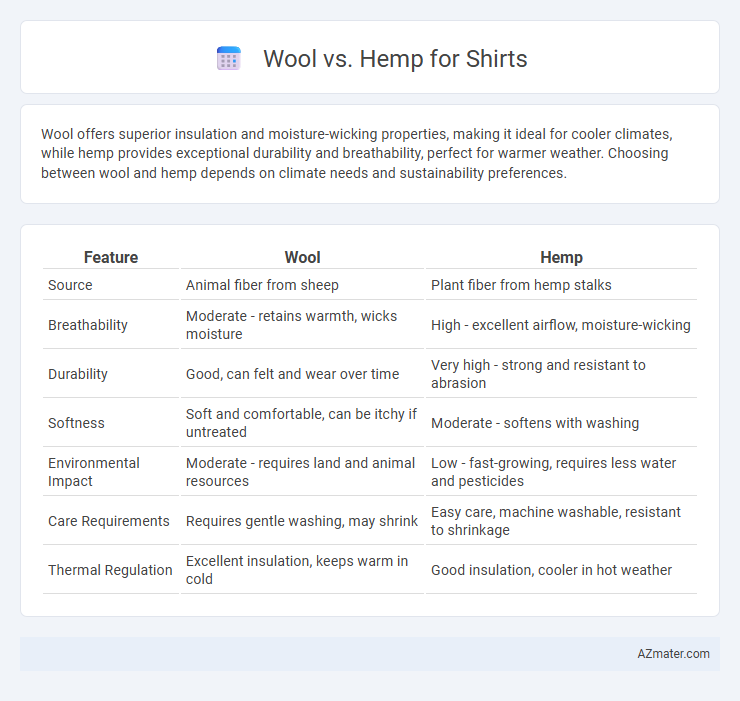Wool offers superior insulation and moisture-wicking properties, making it ideal for cooler climates, while hemp provides exceptional durability and breathability, perfect for warmer weather. Choosing between wool and hemp depends on climate needs and sustainability preferences.
Table of Comparison
| Feature | Wool | Hemp |
|---|---|---|
| Source | Animal fiber from sheep | Plant fiber from hemp stalks |
| Breathability | Moderate - retains warmth, wicks moisture | High - excellent airflow, moisture-wicking |
| Durability | Good, can felt and wear over time | Very high - strong and resistant to abrasion |
| Softness | Soft and comfortable, can be itchy if untreated | Moderate - softens with washing |
| Environmental Impact | Moderate - requires land and animal resources | Low - fast-growing, requires less water and pesticides |
| Care Requirements | Requires gentle washing, may shrink | Easy care, machine washable, resistant to shrinkage |
| Thermal Regulation | Excellent insulation, keeps warm in cold | Good insulation, cooler in hot weather |
Introduction: Wool vs Hemp Shirts
Wool shirts offer natural insulation, moisture-wicking properties, and durability, making them ideal for cold weather and active wear. Hemp shirts provide exceptional breathability, antimicrobial benefits, and environmental sustainability, thanks to the plant's rapid growth and minimal pesticide use. Choosing between wool and hemp shirts depends on factors like climate, comfort preferences, and eco-consciousness.
Fiber Origins: Understanding Wool and Hemp
Wool fibers originate from the fleece of sheep, known for their natural crimp and insulating properties that provide warmth and moisture-wicking capabilities. Hemp fibers come from the stalks of the Cannabis sativa plant, offering a strong, breathable, and eco-friendly fabric with antimicrobial qualities. Understanding these fiber origins highlights wool's animal-based warmth and hemp's sustainable plant-based durability for shirt production.
Sustainability Comparison: Eco-Impact of Wool and Hemp
Wool production relies on sheep farming, which contributes to greenhouse gas emissions and requires significant water and land resources, impacting sustainability. Hemp cultivation demands less water and pesticides, enriches soil through phytoremediation, and provides faster growth cycles, making it a more eco-friendly fiber option. Comparing the eco-impact, hemp shirts generally have a lower environmental footprint compared to conventional wool counterparts.
Comfort and Breathability
Wool offers excellent insulation and moisture-wicking properties, making it comfortable in both cool and warm conditions, while its natural elasticity enhances wearer comfort. Hemp fabric is highly breathable and lightweight, promoting airflow and reducing sweat buildup, ideal for hot and humid climates. Both fibers provide durability, but wool's finer texture feels softer against the skin compared to the coarser feel of hemp.
Durability and Longevity
Hemp fabric is renowned for its exceptional durability due to its strong, coarse fibers that resist wear and tear over time, making hemp shirts highly long-lasting. Wool, while softer and elastic, tends to be less abrasion-resistant but offers natural resilience and shape retention, which contributes to moderate longevity when properly cared for. Both materials provide sustainable options, yet hemp generally surpasses wool in durability and lifespan for shirt fabrics.
Moisture-Wicking and Odor Resistance
Hemp shirts outperform wool in moisture-wicking due to hemp's highly breathable fibers that effectively draw sweat away from the skin, keeping the wearer dry. Wool excels in odor resistance because of its natural lanolin content, which inhibits bacterial growth responsible for smells. Choosing between hemp and wool depends on whether moisture management or long-lasting odor control is the priority for performance wear.
Allergies and Skin Sensitivity
Wool can trigger allergic reactions or skin irritation in individuals with sensitive skin due to its lanolin content and coarse fibers. Hemp fabric, known for its hypoallergenic and breathable properties, is less likely to cause allergies or discomfort, making it suitable for sensitive skin types. Both materials offer natural benefits, but hemp provides a gentler option for those prone to skin sensitivities or eczema.
Style and Aesthetics
Wool shirts offer a classic, refined appearance with natural texture variations that provide warmth and a sophisticated drape ideal for formal and casual wear. Hemp shirts feature a slightly coarser weave with a matte finish, delivering a rustic, eco-friendly aesthetic that ages well and softens with each wash. Both fibers support versatile design choices, but wool's natural elasticity enhances fit and movement, while hemp emphasizes durability and a unique, earthy style.
Care and Maintenance
Wool shirts require gentle hand washing or dry cleaning to maintain fiber integrity, avoiding high heat that causes shrinkage and pilling. Hemp shirts boast natural durability and resist wrinkles, allowing for more frequent machine washing without significant wear. Both fabrics benefit from air drying and storing in a cool, dry place to prevent mold and maintain longevity.
Cost Analysis and Value
Wool shirts typically have a higher upfront cost due to the labor-intensive processing and quality of fibers, with prices ranging from $50 to over $200 per garment. Hemp shirts, while generally more affordable, averaging $30 to $80, offer durable and eco-friendly qualities that enhance long-term value through increased longevity and sustainability. The cost analysis reveals wool's premium price aligns with its thermal and moisture-wicking properties, whereas hemp provides a cost-effective alternative with strong environmental benefits, making each fabric's value dependent on consumer priorities and usage needs.

Infographic: Wool vs Hemp for Shirt
 azmater.com
azmater.com